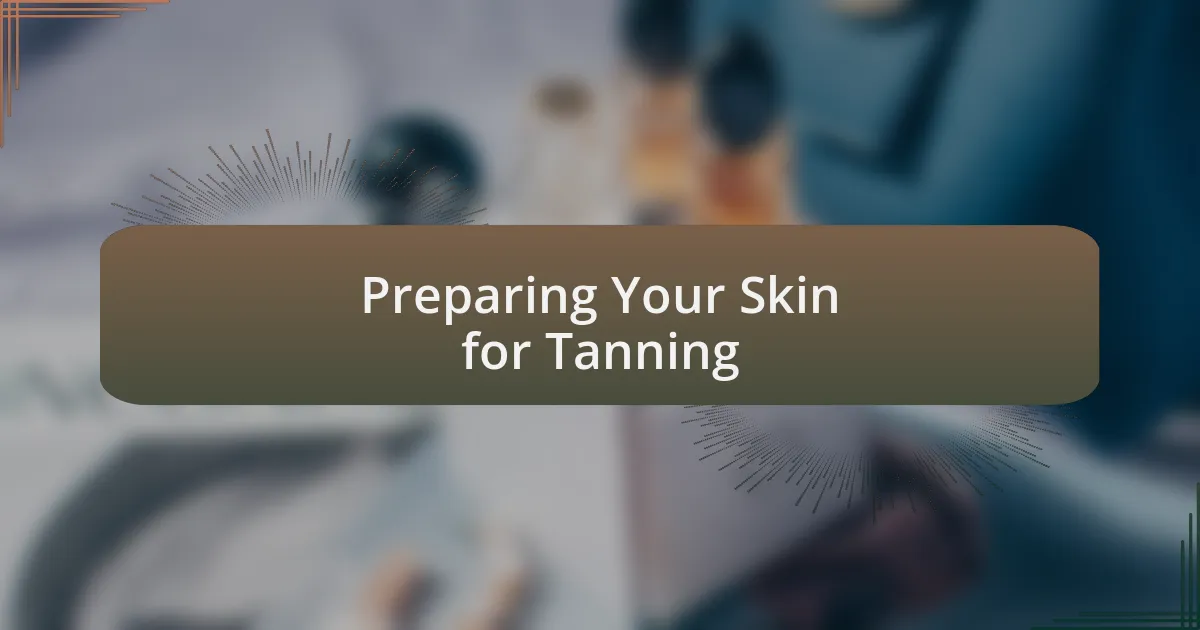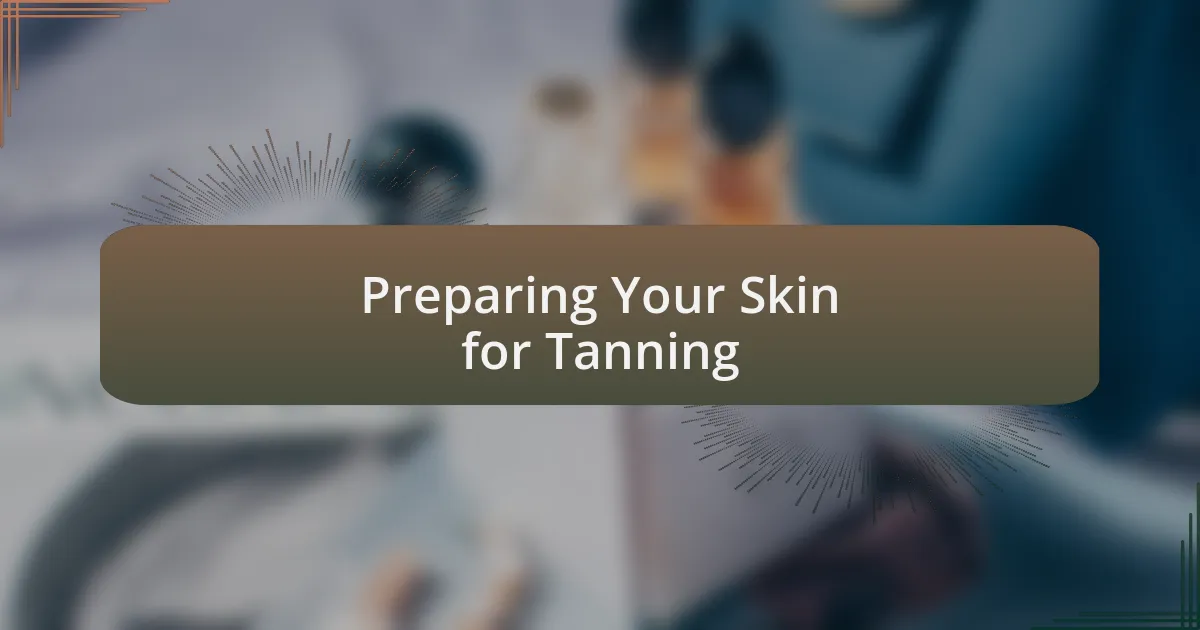Key takeaways:
- Understanding self-tanner ingredients, especially DHA, is essential for achieving a flawless tan.
- Even application is crucial to avoid streaks and enhance the natural appearance of the tan.
- Preparing the skin through cleansing and exfoliation leads to a smoother, more even application.
- Using the right tools, like application mitts and brushes, significantly improves the tanning experience and outcomes.

Understanding Self-Tanner Products
Self-tanner products come in various forms, including lotions, mousses, and sprays, each offering unique application experiences. I remember the first time I tried a tinted self-tanner; it felt like a magical transformation as my fair skin turned a warm caramel hue. However, the initial excitement quickly turned into a concern about uneven patches. Isn’t it amazing how much a simple tan can impact your confidence?
Understanding the active ingredients in self-tanners is crucial for achieving that flawless glow. Most contain dihydroxyacetone (DHA), a compound that reacts with the amino acids in your skin. This reaction creates a temporary color change, but it’s a process that can be tricky. Have you ever applied a self-tanner and worried about those little streaks appearing? I certainly have, and knowing the science behind the product helped me choose the right one for my skin type.
Another aspect to consider is the importance of skin preparation before applying self-tanner. I learned the hard way that exfoliating can truly make a difference—skipping that step led to a blotchy application on my first try. Imagine the joy of applying a self-tanner and not having to stress about unevenness! Understanding these subtleties not only enhances your experience but also helps you feel more at ease as you embrace a sun-kissed look.

Importance of Even Application
Even application is crucial when using self-tanner because uneven patches can easily ruin an otherwise perfect tan. I recall one summer where I was so eager to achieve that sun-kissed look for a beach trip, but I ended up with noticeable streaks on my arms. It was such a letdown! Those little imperfections can make you feel less confident, don’t you think?
Another reason even application matters is that it promotes a natural look. I remember a friend who once applied self-tanner without being mindful of blending it well. The harsh lines on her ankles were hard to ignore, and they drew more attention than she intended. Isn’t it fascinating how something as simple as proper application can have such a profound impact on how we’re perceived?
Moreover, an even application not only enhances the appearance but also extends the longevity of your tan. In my experience, I’ve noticed that when I take the time to apply self-tanner evenly, it fades more gracefully. Have you ever experienced a patchy tan fading into splotches? By putting in the effort for evenness, you can enjoy your glow longer while appreciating how naturally radiant you can look.

Preparing Your Skin for Tanning

Preparing Your Skin for Tanning
Before applying self-tanner, it’s essential to start with clean skin. I remember the time I skipped this step and ended up with a rather patchy tan. Washing my skin to remove any dirt, oil, or residual products truly makes all the difference in ensuring an even application. Have you ever felt like your tan just wasn’t taking? That might be the culprit!
Exfoliation is another crucial step in the preparation process. I’ve found that gently buffing away dead skin helps create a smooth canvas. The first time I exfoliated before tanning, the result was so much better; it felt like my skin absorbed the product beautifully. It’s surprising how much of an impact a little scrub can have on the final color, isn’t it?
Don’t forget to moisturize dry areas like elbows and knees as well. I used to apply self-tanner straight to those areas, thinking it wouldn’t matter. But over time, I noticed they turned darker than the rest of my skin, and I felt so self-conscious! A light layer of moisturizer provides a barrier that helps achieve a more balanced application. Why make the mistake I once did when a little prep can enhance your glow?

Techniques for Applying Self-Tanner
When applying self-tanner, using a mitt can be a game-changer. I recall the first time I ended up with orange palms from a direct application; it was a lesson learned! A mitt ensures even distribution of the product and protects your hands from unwanted stains. Have you ever wished for that seamless look without the mess? This simple tool can elevate your tanning experience significantly.
Timing also plays a crucial role in achieving the desired shade. I learned the hard way that rushing the process often leads to streaks. I like to take my time, applying the tanner in sections and letting each part dry before moving on. This method not only ensures an even application but also helps avoid those dreaded tan lines we all fear.
Lastly, always remember to blend well, particularly in tricky areas like the back of the knees or around the ankles. I spent one summer sporting an amusing tan line behind my knees, and it was hard to feel confident at the beach. I find that bending my knees while applying tanner helps me get into those fussy spots, ensuring an overall natural look. How would you feel flaunting a flawless tan? It’s worth the extra effort!

Tools to Help with Application
Using the right tools can make a world of difference when applying self-tanner. For instance, a high-quality application mitt is indispensable. I still remember the first time I tried to apply self-tanner with my bare hands; it was an orange disaster! By using a mitt, I’ve noticed that not only does it help in achieving an even tan, but it also keeps my hands clean and looking fresh.
In addition to a mitt, consider tools like an application brush for those hard-to-reach areas. I always employ a brush to delicately apply self-tanner along my jawline and on my feet. It’s astonishing how a simple brush can allow for precision that your hands just can’t match. Have you ever struggled to get your tan just right around your ankles? I’ve been there, and trust me, a brush can save you from those awkward blotches.
Lastly, a long-handled back applicator is a game-changer for reaching your back without any help. I can’t overstate the relief I felt the first time I used it; no more awkward stretches or missed spots! It’s incredibly empowering to know you can tackle every inch of your body with confidence. Who wouldn’t want to nail a flawless tan?

Common Mistakes to Avoid
One common mistake I see people make is skipping the exfoliation step. I once tried to apply self-tanner without prepping my skin properly, and I ended up with patchy spots that reminded me of a leopard! Exfoliating ensures a smooth canvas for the tanner, allowing for an even application that lasts longer.
Another error is applying too much product at once. It can be tempting to slather on a lot, thinking it’ll deepen the color instantly. I learned the hard way that building up the tan gradually gives a more natural look, plus it helps avoid those dreaded streaks that can happen when you overapply.
Finally, not blending well can leave you with obvious lines, especially around areas like the knees and elbows. I always take extra time in these spots, blending in circular motions. Have you ever looked in the mirror only to find a line of demarcation? Trust me, a little patience goes a long way in achieving that sun-kissed glow you’re aiming for.

Personal Tips for Best Results
When it comes to applying self-tanner, I’ve found that using the right tools can make all the difference. I prefer a mitt for application; it not only prevents stained palms but also helps to distribute the product evenly. Have you ever noticed how hands can sometimes end up looking like they’ve been in a paint fight? A mitt eliminates that problem and gives you more control, which is crucial for an even finish.
Another tip I’ve learned is to pay close attention to areas that tend to absorb more color, like feet and hands. There was a time I didn’t realize how quickly those areas could darken, and I ended up with feet that were several shades darker than my legs. Now, I use a lighter touch on those spots and blend any excess tanner with a damp cloth to achieve a more balanced look.
Lastly, don’t underestimate the power of timing. I’ve made the mistake of applying self-tanner right before hitting the gym or heading out, which only led to streaks and uneven patches. Allowing the tanner to set for at least a few hours, or ideally overnight, ensures that you wake up to a smooth, flawless tan that looks like you spent a week on a tropical beach. Does that sound better than a hurried application? Absolutely!